-
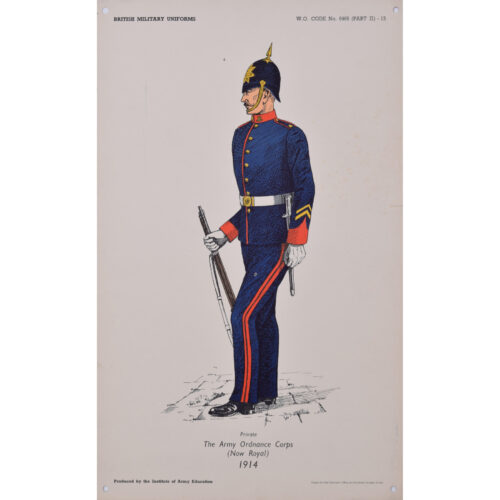
The Royal Army Ordnance Corps (now Royal Logistics Corps) 1914 uniform
Lithograph 50 x 31 cm Produced for the Institute of Army Education. Printed for HM Stationery Office by I A Limited, Southall 51. These posters were produced by the Institute of Army Education, likely for display in barracks. Created in the 1950s, they illustrate the 'vintage' uniforms worn by the Corps during the First World War. Condition: punched holes to corners as issued; faint spotting and small repaired tear to right. If you are interested, please email info@manningfineart.co.uk or call us on 07929 749056. Click here for other original vintage Institute of Army Education uniform posters. -
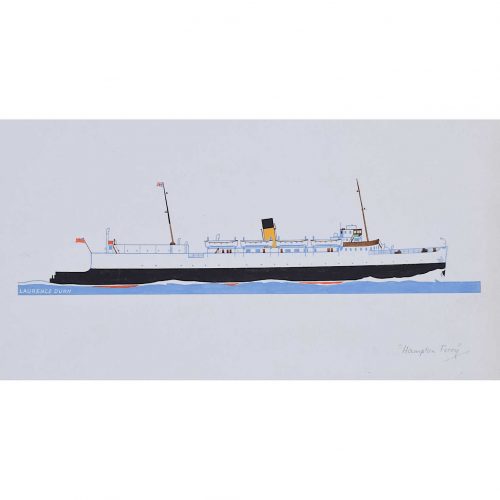
Laurence Dunn (1910-2006)
Hampton Ferry
19.5 x 31.5 cm
Bodycolour and ink on paper Signed l.l.Laurence Dunn (1910-2006) was a well-known British marine artist and writer known for his depictions of ships. He grew up in Devon, where he practised drawing passing ships, and went on to study at the Central School of Art. He then worked for shipbuilding firm John I. Thornycroft & Company Limited, where he contributed to the design of the Royal Yacht. During the Second World War, Dunn worked in naval intelligence. In the early 1960s, he created many line drawings of Atlantic ocean liners.
Upon his death in 2006, the World Ship Society published the following obituary:
DUNN, Laurence. [December 15 2006 — Lloyds List] Many readers will be saddened by the death of well-known marine artist and writer Laurence Dunn in his 97th year. A man of encyclopaedic knowledge, he began his lifelong love of ships in Brixham, where he meticulously recorded passing traffic with the exquisitely accurate line drawings which later became something of a trademark. While studying at London’s Central School of Art his work was noticed by the Southern Railway, which commissioned profiles of its fleet, and this in turn led to work for Orient Line, where he also designed the well-known corn-coloured hull, and later Thorneycroft, where he helped with shaping draft plans for a new royal yacht. During the second world was he worked for naval intelligence at the Admiralty, where his technique did much to improve recognition standards, and greatly expanded his shipping clientele, becoming personally known to many chairmen. As well as the shipping press he worked for mainstream publications such as Everybody’s, Sphere and the upmarket comic Eagle. Through his many contacts he enjoyed going to sea in a great variety of ships from aircraft carriers to colliers. Laurence wrote several books, starting with ship recognition titles which introduced new standards of layout, but his best known work was probably Passenger Liners, which was widely taken up by the travel trade. His love of Greece, where he was an early publicist of island cruising, let to involvement in reshaping various passenger liners beginning with Greek Line’s OLYMPIA. In later life he designed several sets of shipping stamps for the Crown Agents, produced photographic volumes on Thames and Mediterranean shipping and still found time to enjoy the passing Thames traffic. Our sympathies go to his wife Jennifer, who provided succour to the many ship lovers who beat a path to the welcoming door of their Gravesend home.
-
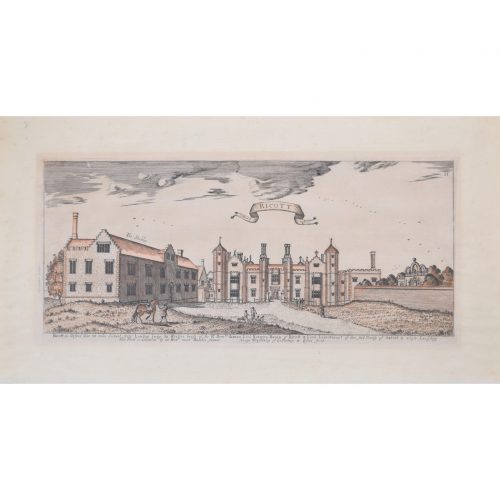
Henry Winstanley (1644 - 1703)
Rycote House, Oxfordshire
Engraving 19 x 44 cm Rycote House, Oxfordshire, was a Tudor (and later Georgian) country house. The house was built in the 16th century, and in 1920, after a period of decline, the extensive stables were converted into the present Rycote House. Condition: generally very good; some age toning. If you are interested, please email info@manningfineart.co.uk or call us on 07929 749056. Click here for other architectural drawings. -
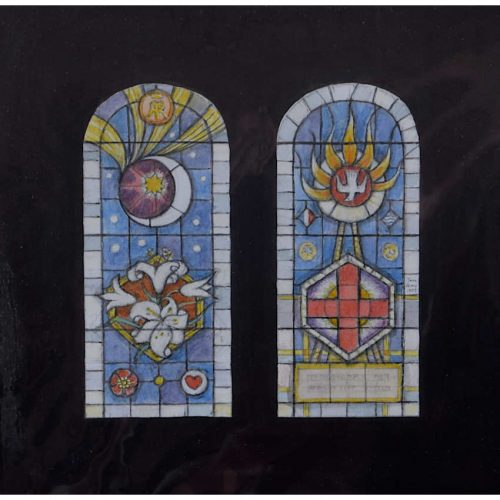
Jane Gray (b.1931)
All Saints Church, North Hillingdon, Design for Stained Glass Window (1982)
Watercolour 15 x 14 cm Studio label verso.All Saints Church, North Hillingdon was constructed in 1930—one of the first of 45 new churches from “The Forty-Five Church Funds” to build new sites of worship in and around the diocese of London. The church was designed by Sir Charles Nicholson and built in Metroland to serve families being moved from inner London. In 1932, the foundations of the church were laid and it was consecrated by in 1933 by the Bishop of Kensington.
Provenance: the artist’s studio sale. Condition: very good. If you are interested, please email info@manningfineart.co.uk or call us on 07929 749056. For other works by Jane Gray and more information about her, please click here. -
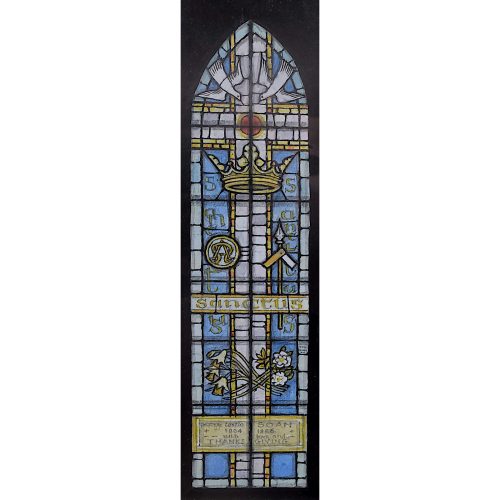
Jane Gray (b.1931)
All Saints Church, Lightwater, Surrey, Design for Stained Glass Memorial Window (1987)
Watercolour 18 x 5 cm Signed and dated verso.All Saints Church in Lightwater, Surrey was built and dedicated in 1903. Prior to this, services were held in Florence Laundry in Guildford Road as, at that time, Lightwater was a small hamlet. With the development of nurseries and cottages to house the influx of workers that followed soon after, the Conventional District of All Saints’ was formed in 1931. Before this, All Saints Church had been a daughter church of Windlesham. A Priest-in-Charge was appointed shortly after the split in 1931 and a vestry extension was added to the building. This window features a background Cross, symbols and flowers and was installed in 1988.
Provenance: the artist’s studio sale. Literature: Jane Gray, Playing with Rainbows. (Shropshire: Ellingham Press, 2011), p.79. Condition: very good. If you are interested, please email info@manningfineart.co.uk or call us on 07929 749056. For other works by Jane Gray and more information about her, please click here. -

Jane Gray (b.1931)
St Wilfrid’s Church, Ribchester, Lancashire, Design for Stained Glass Memorial Window (1995)
Watercolour 20.5 x 3.5 cm Signed, dated and studio stamp verso.St Wilfrid’s Church, Ribchester is situated in the picturesque Ribble Valley, in the heart of rural Lancashire, and dates back to the 13th century. It has since undergone several alterations in the 14th, 15th and 16th centuries as well as substantial restoration works in the 17th, 18th and 19th centuries. The village of Ribchester grew out of the ruins of the Roman fort of Bremetenaccum and the Parish Church of St Wilfrid's stands where the key buildings of the fort would have been. This window was installed in 1996.
Provenance: the artist’s studio sale. Literature: Jane Gray, Playing with Rainbows. (Shropshire: Ellingham Press, 2011), p.84. Condition: very good. If you are interested, please email info@manningfineart.co.uk or call us on 07929 749056. For other works by Jane Gray and more information about her, please click here. -
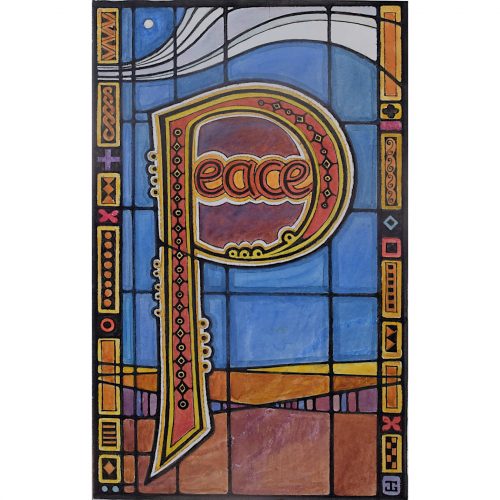
Jane Gray (b.1931)
‘Peace’ Design for a Christmas Card (1989)
Watercolour 24.5 x 14.5 cm Dated, detailed in artist’s hand and studio stamp verso.This simple but effective design for a Christmas card from 1989 beautifully demonstrates Gray’s modernist style, with her recognisably colourful palette and simple yet detailed delineation of her geometric, lettered design.
Provenance: the artist’s studio sale. Condition: very good. If you are interested, please email info@manningfineart.co.uk or call us on 07929 749056. For other works by Jane Gray and more information about her, please click here. -

Jane Gray (b.1931)
Gatton Church, nr Redhill, Surrey, Design for Stained Glass Window (1979)
Watercolour 15.5 x 8.5 cmDated. Signed verso.
A church has existed in this Surrey parish since the Doomsday Survey in 1086 but the present Church dates back to the 13th century, undergoing extensive alterations in the 18th and early 19th centuries. Notably, in 1834, the pulpit and altar, bought from Nuremberg, were hopefully attributed to Albrecht Dürer; the carved doors had travelled from Rouen; the presbytery stalls from a disestablished monastery in Ghent, the altar rails from Tongeren; and the stained glass for the windows, and the wainscoting of the nave and carved canopies had come from Aarschot, near Leuven. This tiny church window was one of Gray’s smallest commissions. Her brief was to include the church at the heart of the Gatton agricultural community, and she did, supplementing this with illustrations of corn, oats, barley, poppies, bees, butterflies, ladybirds, a caterpillar and a grasshopper, alongside small roundels set amongst these containing a calf, a tractor, and a combine harvester respectively. The window was installed in 1980.
Provenance: the artist’s studio sale. Literature: Jane Gray, Playing with Rainbows. (Shropshire: Ellingham Press, 2011), pp.41, 76. Condition: very good. If you are interested, please email info@manningfineart.co.uk or call us on 07929 749056. For other works by Jane Gray and more information about her, please click here. -
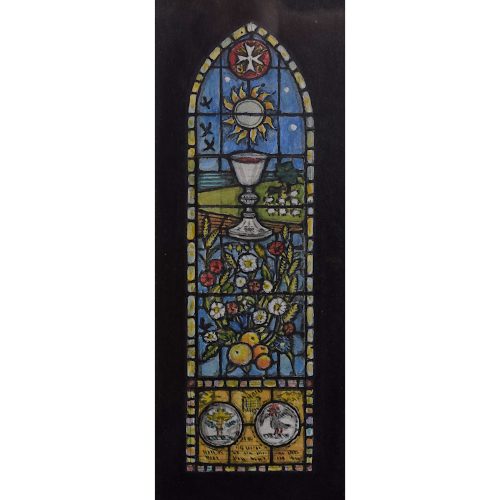
Jane Gray (b.1931)
Church of St Peter and St John the Baptist, Wivelsfield, Sussex, Design for Stained Glass Memorial Window (1993)
Watercolour 16.5 x 5.5 cmSigned, dated and studio stamp verso.
The country Church of St Peter and St John the Baptist in Wivelsfield, East Sussex, dates back to around the 11th century. Since then it has undergone several renovations; the south aisle is 13th century, the tall south chapel is 14th century, the southwest tower was built around 1500 and the chancel was lengthened in the 19th century. Originally, the church was a chapelry of Ditchling, and it wasn't until after the Reformation that the church separated completely. This window was commissioned to commemorate Sir Bryant Godman Irvine, former Deputy Speaker of the House of Commons, and to his wife, and features both their family crests. The window was installed in 1995.
Provenance: the artist’s studio sale. Literature: Jane Gray, Playing with Rainbows. (Shropshire: Ellingham Press, 2011), p.84. Condition: very good. If you are interested, please email info@manningfineart.co.uk or call us on 07929 749056. For other works by Jane Gray and more information about her, please click here. -

Jane Gray (b.1931)
St Mary’s Church, Harmondsworth, Design for Stained Glass Window (1982)
Watercolour 11.5 x 4.5 cmStudio stamp verso.
St Mary’s Church, the Parish Church of Harmondsworth, dates from the 12th-15th centuries. The South aisle, with its massive Norman columns, and the entrance are the oldest parts of the building still intact today. The North aisle dates from the 13th Century, the North Chapel the 14th Century, the chancel was remodelled in the 15th Century, and the tower was built in 1500. In the 19th century the church underwent extensive restoration and a porch and vestry were added but the original Norman font still exists today. This window features a red Cross and a wreath of flowers, and was installed in the church in 1983.
Provenance: the artist’s studio sale. Literature: Jane Gray, Playing with Rainbows. (Shropshire: Ellingham Press, 2011), p.77. Condition: very good. If you are interested, please email info@manningfineart.co.uk or call us on 07929 749056. For other works by Jane Gray and more information about her, please click here. -
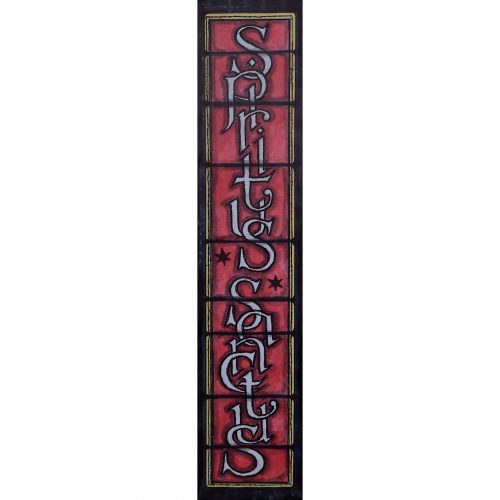
Jane Gray (b.1931)
St Peter’s Church, Cound, Shropshire, Design for Stained Glass Lettered Panel (1999)
Watercolour 24.5 x 5 cmStudio stamp verso.
St Peter’s Church, Cound lies in the grounds of the Cound Hall estate and is dedicated to St Peter because of its medieval association with Shrewsbury Abbey (dedicated to Saints Peter and Paul). The oldest part of the present church dates back to the 13th century but it has been renovated several times since then, with additions from the 14th, 15th and 19th centuries. This unique design by Gray highlights her modern style, the simple lettered panel, bearing the Latin name for the holy spirit, brimming with vibrant energy.
Provenance: the artist’s studio sale. Literature: Jane Gray, Playing with Rainbows. (Shropshire: Ellingham Press, 2011), p.86. Condition: very good. If you are interested, please email info@manningfineart.co.uk or call us on 07929 749056. For other works by Jane Gray and more information about her, please click here. -
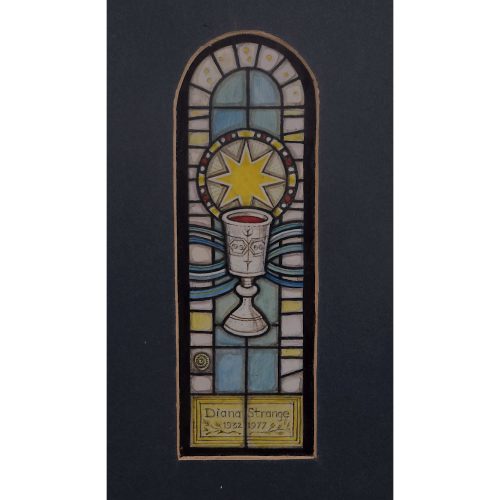
Jane Gray (b.1931)
St Nicholas Church, Worth Matravers, Dorset, Design for Memorial Stained Glass Window (1978)
Watercolour 15.5 x 5 cmDated and detailed in artist’s hand with studio label verso.
St Nicholas Church in Worth Matravers is one of the oldest churches in Dorset. It was built around the year 1100 AD. Though the majority of the church is Norman, some of the stonework appears to come from an earlier building, suggesting that there was a church here in the late Saxon period. This memorial window commemorates Diana Strange who died tragically in 1977. It was commissioned by her husband who was a keen admirer of Gray’s work and centres on the Elizabethan chalice used in St Nicholas’ Church. The window directly opposite contains another memorial window designed by Gray for Diana’s Husband, John Strange, who died seven years later. Diana's memorial window was installed in 1979.
Provenance: the artist’s studio sale. Literature: Jane Gray, Playing with Rainbows. (Shropshire: Ellingham Press, 2011), pp.22, 75. Condition: very good. If you are interested, please email info@manningfineart.co.uk or call us on 07929 749056. For other works by Jane Gray and more information about her, please click here. -
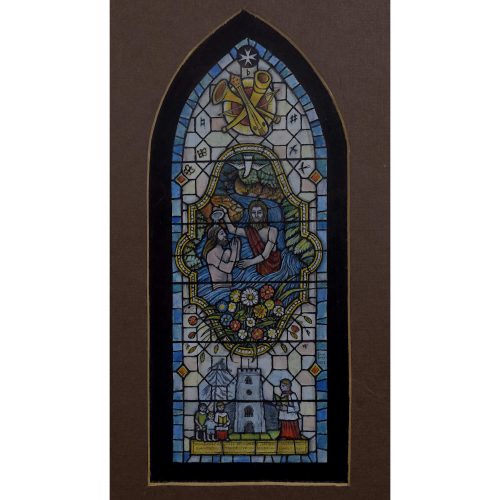
Jane Gray (b.1931)
St John’s Church, Broughton, Design for Stained Glass Window (1983)
Watercolour 20 x 9 cmStudio label verso.
St John’s Church, in rural Preston, began as a wooden family chapel for the Lord of the Manor in the 12th century. This chapel, however, was demolished in 1823. Since then, the rebuilt sandstone church has been remodelled a number of times, the oldest part of the existing church, the tower, dating back to 1533 during Henry VIII’s reign. This window centres on the baptism of Christ by St John and features symbolic imagery of music, flowers, harvest, birds, insects, choristers, schoolchildren, and the church itself. The window was installed in 1985.
Provenance: the artist’s studio sale. Literature: Jane Gray, Playing with Rainbows. (Shropshire: Ellingham Press, 2011), p.78. Condition: very good. If you are interested, please email info@manningfineart.co.uk or call us on 07929 749056. For other works by Jane Gray and more information about her, please click here. -
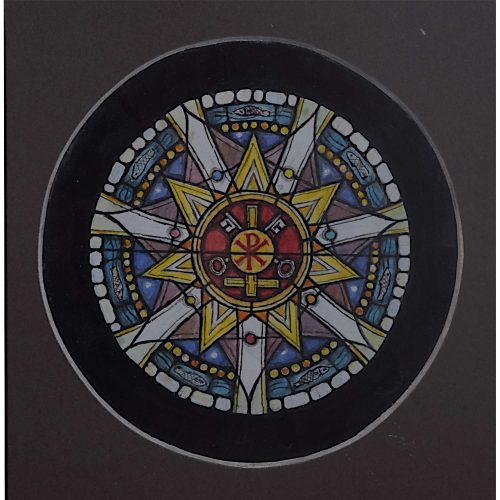
Jane Gray (b.1931)
St Peter’s Church, Monkmoor Road, Shrewsbury, Design for Stained Glass Window (1990)
Watercolour D.12 cmSigned, dated and studio stamp verso.
St Peter’s is a small, modern mission church adjoining Shrewsbury Abbey and was consecrated shortly before the outbreak of World War II in 1939. Gray’s stained glass design sensitively yet strikingly reflects this simple site of religious worship in her typical modern-medieval style. Important numbers in Christian iconography are included: three for the Trinity (Body, Mind, and Spirit), four for the material world of the Elements, and so, together, seven which combines the worlds of matter and spirit and is thus regarded as the perfect number. At the centre of the window sits the Chi-Ro, or monogram of Christ, placed against the emblems of St Peter (a pair of crossed keys and an inverted Latinate cross). Surrounding the design, seven fish swim in a turquoise sea. The window was installed in 1992.
Provenance: the artist’s studio sale. Literature: Jane Gray, Playing with Rainbows. (Shropshire: Ellingham Press, 2011), pp.48, 81. Condition: very good. If you are interested, please email info@manningfineart.co.uk or call us on 07929 749056. For other works by Jane Gray and more information about her, please click here. -
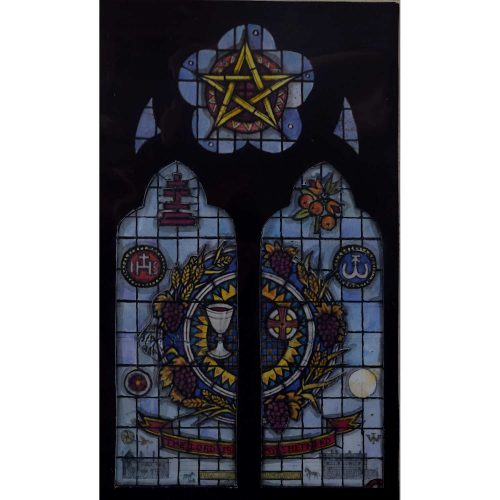
Jane Gray (b.1931)
St Barnabas Church, Franche, Kidderminster, Design for Stained Glass Window (1993)
Watercolour and Photographic Collage 21.5 x 13 cmSigned, dated and studio stamp verso.
St Barnabas Church, a red brick church designed by Martin & Chamberlain, was established in Franche in 1871 as a chapel-of-ease to the Parish Church of Kidderminster, St Mary and All Saints. St Barnabas is known for its diverse collection of stained glass windows and, alongside Gray’s modern memorial window, features windows in the Arts and Crafts style, likely designed by Benjamin Warren.
Provenance: the artist’s studio sale. Condition: very good. If you are interested, please email info@manningfineart.co.uk or call us on 07929 749056. For other works by Jane Gray and more information about her, please click here. -
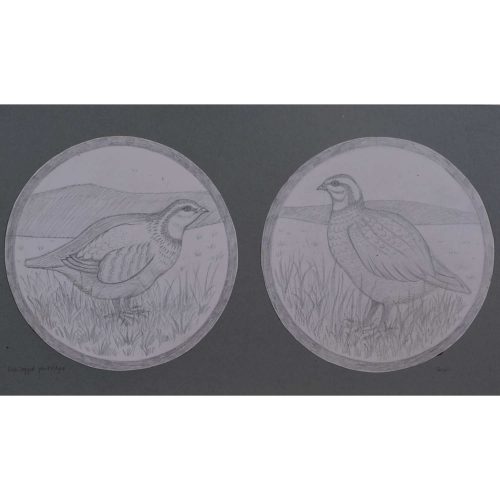
Jane Gray (b.1931)
Game Bird Designs for Stained Glass Roundels (1987)
Watercolour D.18.5 cm (x2)Dated and detailed in the artist's hand verso.
These pencil-sketched designs for two stained glass roundels charmingly depict a red legged partridge and quail set against simple pastoral backgrounds. Gray spent the later years of her life in the rural countryside of Shropshire and was fond of the natural world around her, plants and flowers, in particular, often featuring in her religious and secular work.
Provenance: the artist’s studio sale. Condition: very good. If you are interested, please email info@manningfineart.co.uk or call us on 07929 749056. For other works by Jane Gray and more information about her, please click here. -
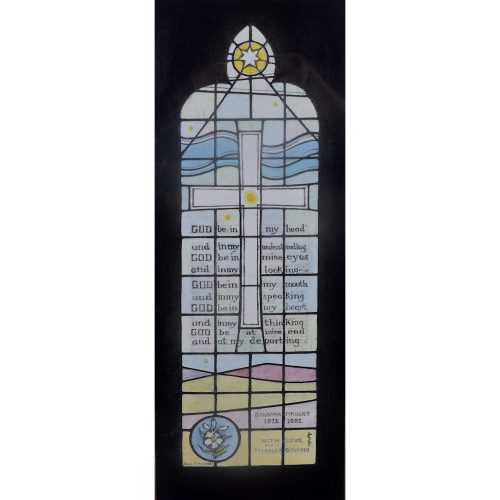
Jane Gray (b.1931)
Pishill Church, Henley-on-Thames, Design for Stained Glass Memorial Window (1983)
Watercolour 21 x 7.5 cmSigned, dated and artist label verso.
Pishill Church is a highly unusual T-shaped, flint and stone Norman church that was built in the early 12th century but underwent substantial interior alterations in the Early English and Decorated Styles in the 19th century. The church is charmingly situated on a hilltop overlooking the Stonor Valley and Hamlet of Pishill, and boasts several spectacular stained glass windows, including one designed by John Piper in 1967. This design commemorates Gray’s favourite Aunt who requested a memorial window in Pishill Church upon her death in 1981. This simple arrangement used acid-etched lettering to quote Gray’s aunt’s favourite prayers against a plain background representing the elements. The window was installed in 1985.
Provenance: the artist’s studio sale. Literature: Jane Gray, Playing with Rainbows. (Shropshire: Ellingham Press, 2011), p.24, 78. Condition: very good. If you are interested, please email info@manningfineart.co.uk or call us on 07929 749056. For other works by Jane Gray and more information about her, please click here. -
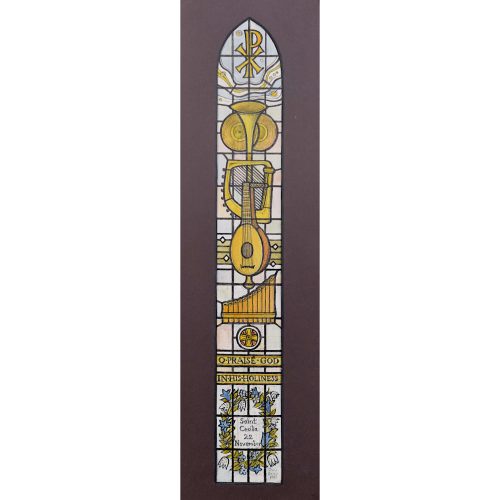
Jane Gray (b.1931)
St Peter's Church, Martindale, Design for Stained Glass Window (1980)
Watercolour 29.5 x 4.5 cm Signed and dated verso. St Peter’s Church was built in Martindale, Cumbria in 1880 by a local craftsman using stone from the surrounding area. The church is situated in an enchanting rural oasis and has connections to the acclaimed modern poet, Kathleen Raine, who lived in the Old Vicarage, as well as William and Dorothy Wordsworth who visited the area on one of their Cumbrian excursions. Gray's 'Martindale Era' lasted from 1974-81, in which time, she designed and installed fifteen stained glass windows in St Peter's Church. This window was designed in memory of Charles Barrand, the vicar at Martindale, who died in 1981. Alongside the cymbals, harp, pipes, horn, and musical notes to celebrate the musical Saint Cecilia, are some of the flowers the vicar grew in the vicarage garden and his favourite psalm: number 150. Provenance: the artist’s studio sale. Literature: Jane Gray, Playing with Rainbows. (Shropshire: Ellingham Press, 2011), pp.20, 74. Condition: very good. If you are interested, please email info@manningfineart.co.uk or call us on 07929 749056. For other works by Jane Gray and more information about her, please click here. -
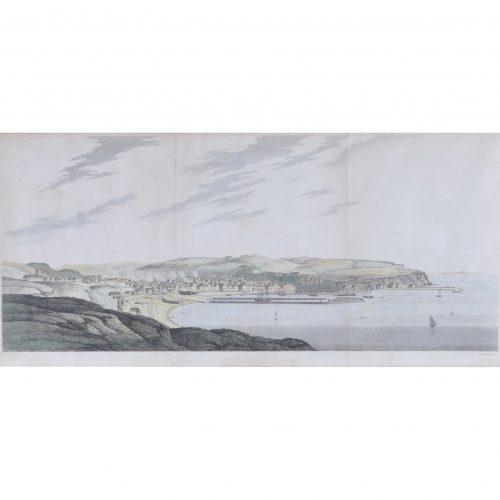
Elizabeth Byrne (1777 - 1849) after Joseph Farington RA (1747 - 1821)
North View of Whitehaven, Cumbria
Hand-coloured engraving 27.5 x 56.5 cm A view of the cliffs and port of Whitehaven in Cumbria. Joseph Farington RA was an 18th-century English landscape painter and diarist. He drew a north and south view of Whitehaven, which were engraved by Elizabeth Byrne in the early 19th century. Byrne was a London-born etcher and landscape painter, who was taught by her father, the etcher William Byrne. She and her father contributed etchings to the 'Magna Britannia' and 'Britannia depicta', books illustrating the most interesting views in various English counties, published by Samuel Lysons in the late 1810s. Condition: good. Two folds and some light age toning. If you are interested, please email info@manningfineart.co.uk or call us on 07929 749056. -
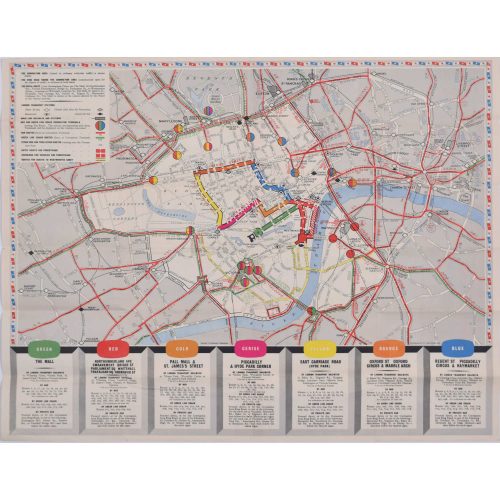
Coronation Arrangements - Map of London (1953)
Lithograph 45 x 60 cm (unfolded) Published by London Transport for the Coronation of Elizabeth II, this delightfully-coloured map illustrates the route taken by the Queen when she was crowned in 1953. Condition: generally very good. If you are interested, please email info@manningfineart.co.uk or call us on 07929 749056. -
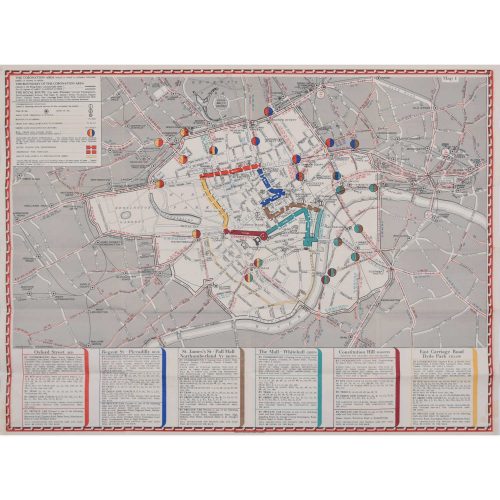
Coronation Arrangements - Map of London (1937)
Lithograph 45 x 60 cm (unfolded) Published by London Transport for the Coronation of George VI, this map illustrates the route the King took in 1936. And best of all, it's just (almost!) as useful in today's London. Condition: generally very good. If you are interested, please email info@manningfineart.co.uk or call us on 07929 749056. -
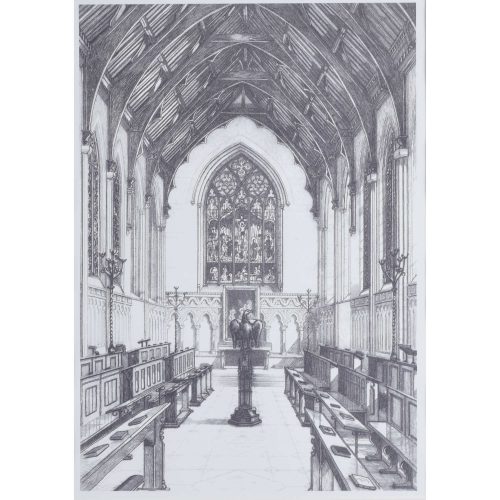
Tony Broderick (late 20th century) Chapel of Corpus Christi College, Cambridge
Print 37 x 25 cm A Lincoln-based artist known for his pictures of Lincoln and also of Cambridge's colleges. Condition: very good. If you’d like to know more, please email info@manningfineart.co.uk or call us on 07929 749056. Click here for other views of Corpus Christi. -
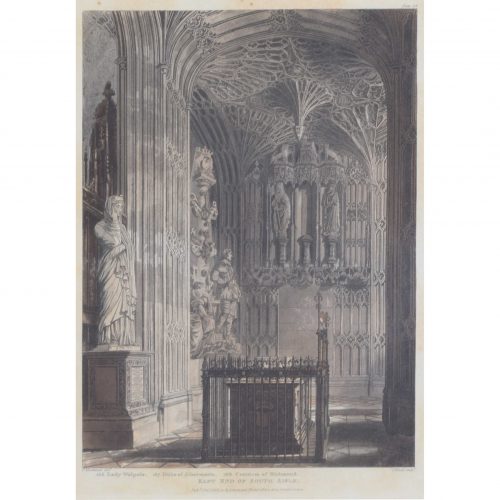
J Black (early 19th century) after Frederick Mackenzie (1788 - 1854)
East End of South Aisle, Westminster Abbey (1812)
Hand-coloured aquatint 31 x 24 cm Published by Rudolph Ackermann (1764 - 1834). An engraving of the East End of Westminster Abbey's south aisle. Mackenzie's drawing was engraved by Black and published by Ackermann in his 1812 "History of Westminster Abbey". Charles II, Queen Anne, Queen Mary II and her husband King William III, and Mary, Queen of Scots are all buried in the south aisle. The Abbey is an historic, mainly Gothic church in the City of Westminster, London, just to the west of the Palace of Westminster. It is one of the United Kingdom's most notable religious buildings and since Edward the Confessor, a burial site for English and, later, British monarchs. Since the coronation of William the Conqueror in 1066, all coronations of English and British monarchs have occurred in Westminster Abbey. Sixteen royal weddings have occurred at the abbey since 1100. According to a tradition first reported circa 1080, a church was founded at the site (then known as Thorney Island) in the seventh century, in the time of Mellitus, Bishop of London. Construction of the present church began in 1245 on the orders of Henry III. Frederick Mackenzie (1788 - 1854) was a British watercolourist and architectural draughtsman. He first exhibited at the Royal Academy in 1804, and contributed eleven drawings between that year and 1828. He contributed to the Society of Painters in Water Colours exhibitions from 1813, becoming an associate in 1822, and a full member the following year. From 30 November 1831 till his death he was treasurer to the society. In later life Mackenzie was no longer commissioned to illustrate books. Rudolph Ackermann was an Anglo-German bookseller, inventor, lithographer, publisher and businessman. In 1795 he established a print-shop and drawing-school at 96 Strand. Here Ackermann set up a lithographic press and began a trade in prints. He later began to manufacture colours and thick carton paper for landscape and miniature painters. Within three years the premises had become too small and he moved to 101 Strand, in his own words "four doors nearer to Somerset House", the seat of the Royal Academy of Arts. Between 1797 and 1800 Ackermann rapidly developed his print and book publishing business, encompassing many different genres including topography, caricature, portraits, transparencies and decorative prints. Condition: good. Some age toning. If you’d like to know more, please email info@manningfineart.co.uk or call us on 07929 749056. -

J Black (early 19th century) after Frederick Mackenzie (1788 - 1854)
The Choir, Westminster Abbey (1812)
Hand-coloured aquatint 28 x 19 cm Published by Rudolph Ackermann (1764 - 1834). An engraving of the vast and soaring interior of Westminster Abbey. Mackenzie's drawing was engraved by Black and published by Ackermann in his 1812 "History of Westminster Abbey". The Abbey is an historic, mainly Gothic church in the City of Westminster, London, just to the west of the Palace of Westminster. It is one of the United Kingdom's most notable religious buildings and since Edward the Confessor, a burial site for English and, later, British monarchs. Since the coronation of William the Conqueror in 1066, all coronations of English and British monarchs have occurred in Westminster Abbey. Sixteen royal weddings have occurred at the abbey since 1100. According to a tradition first reported circa 1080, a church was founded at the site (then known as Thorney Island) in the seventh century, in the time of Mellitus, Bishop of London. Construction of the present church began in 1245 on the orders of Henry III. Frederick Mackenzie (1788 - 1854) was a British watercolourist and architectural draughtsman. He first exhibited at the Royal Academy in 1804, and contributed eleven drawings between that year and 1828. He contributed to the Society of Painters in Water Colours exhibitions from 1813, becoming an associate in 1822, and a full member the following year. From 30 November 1831 till his death he was treasurer to the society. In later life Mackenzie was no longer commissioned to illustrate books. Rudolph Ackermann was an Anglo-German bookseller, inventor, lithographer, publisher and businessman. In 1795 he established a print-shop and drawing-school at 96 Strand. Here Ackermann set up a lithographic press and began a trade in prints. He later began to manufacture colours and thick carton paper for landscape and miniature painters. Within three years the premises had become too small and he moved to 101 Strand, in his own words "four doors nearer to Somerset House", the seat of the Royal Academy of Arts. Between 1797 and 1800 Ackermann rapidly developed his print and book publishing business, encompassing many different genres including topography, caricature, portraits, transparencies and decorative prints. Condition: good. Some age toning. If you’d like to know more, please email info@manningfineart.co.uk or call us on 07929 749056. -
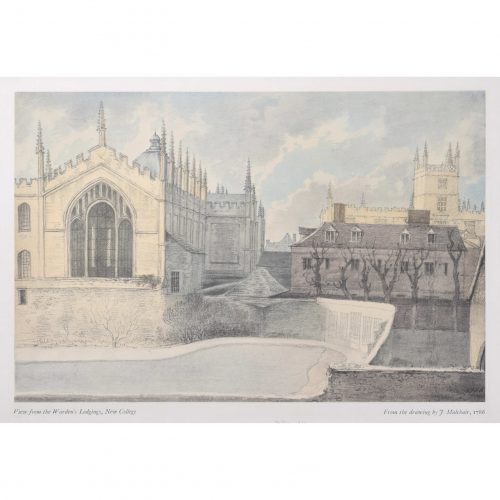
John Baptist Malchair (1730 – 1812)
View from the Master's Lodgings, New College, Oxford (1929)
Lithograph 33 x 46 cm A 1929 lithograph from a 1767 watercolour of New College by John Malchair. The artist's composition highlights the pale stone of New College on a winter's day. The chapel's spires stretch upward into a cold, cloud-filled sky, as do the bare branches of the trees. Malchair's watercolour (which is held by the Ashmolean museum) was reproduced as a lithograph in 1929, to be published in the "Oxford Almanack". The Oxford Almanack was an annual almanac published by the Oxford University Press for the University of Oxford from 1674 through 2019 (when printing sadly ceased due to "dwindling interest"). The almanac traditionally included engravings or lithographs of the University and information about the upcoming year. Other almanac artists have included James Basire, Michael Burghers, J. M. W. Turner, and John Piper. Malchair was a German-born watercolourist, violinist, drawing master, and collector of traditional European music. He is described as “one of the most distinctive figures of eighteenth century Oxford”, and is recognised as having been an influence on later landscape artists, including John Constable. Malchair was a talented artist, producing hundreds of paintings of English landscapes. His legacy is the collection of hundreds of sketches and watercolours of historical, architectural and topographical interest, particularly of Oxford's medieval buildings. Condition: very good. If you’d like to know more, please email info@manningfineart.co.uk or call us on 07929 749056. -
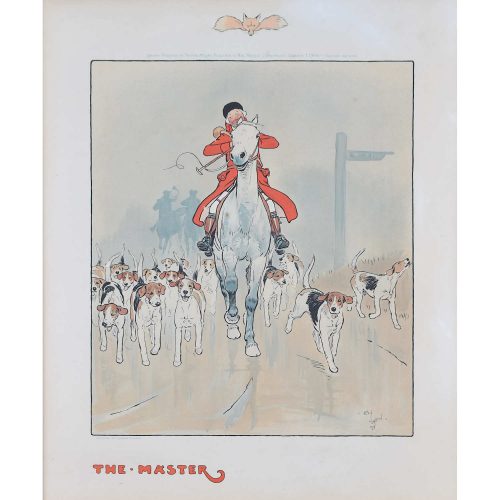
Cecil Aldin (1870 - 1935)
The Master
Lithograph 48 x 40 cm A jolly lithograph of an MFH and his hounds. Cecil Charles Windsor Aldin was a British artist and illustrator best known for his paintings and sketches of animals, sports, and rural life. Aldin executed village scenes and rural buildings in chalk, pencil, and also wash sketching. He was an enthusiastic sportsman and a Master of Fox Hounds, and many of his pictures illustrated hunting. Aldin's early influences included Randolph Caldecott and John Leech. Condition: generally very good, a few marks to margins, one or two marks to frame. -
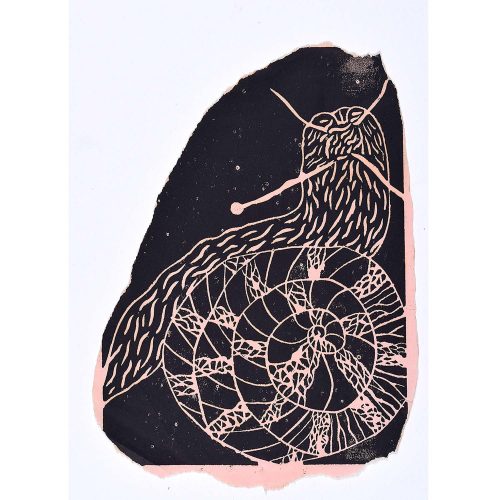
Rosemary Ellis (1910-1988) Snail Sitting Up
23.5x17cm Linocut Provenance: the family of the artist, by descent. Rosemary Ellis (1910-1988)Click here for biographical details and other works by the artist. Clifford and Rosemary Ellis were famous as a husband and wife team for their fascination with nature and their vibrant and charming depictions of animals. They were the natural artists to be commissioned by Collins for their ‘New Naturalists’ series of books, which have become famous and highly collectable more for the dust jackets designed by the Ellises than for the – otherwise excellent – content. This painting is from a recently discovered series of paintings and drawings, never before seen by the general public, dating from the 1940s and 1950s. If you are interested email info@manningfineart.co.uk or call us on 07929 749056. Condition: Good, rough edges as done by artist. -
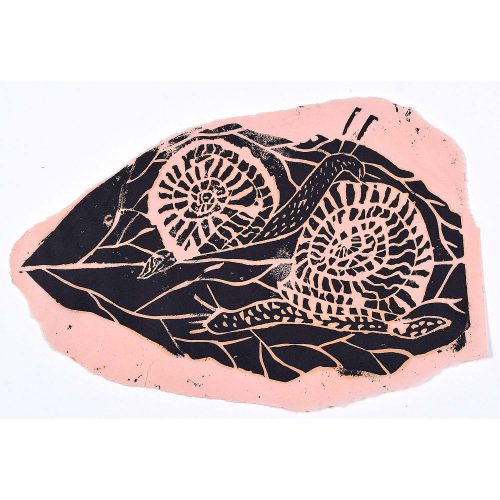
Rosemary Ellis (1910-1988) Snail on Leaf
15x24cm LinocutProvenance: the family of the artist, by descent. Click here for biographical details and other works by the artist. Clifford and Rosemary Ellis were famous as a husband and wife team for their fascination with nature and their vibrant and charming depictions of animals. They were the natural artists to be commissioned by Collins for their ‘New Naturalists’ series of books, which have become famous and highly collectable more for the dust jackets designed by the Ellises than for the – otherwise excellent – content. This painting is from a recently discovered series of paintings and drawings, never before seen by the general public, dating from the 1940s and 1950s. If you are interested email info@manningfineart.co.uk or call us on 07929 749056. Condition: Good, rough edges as done by artist. -
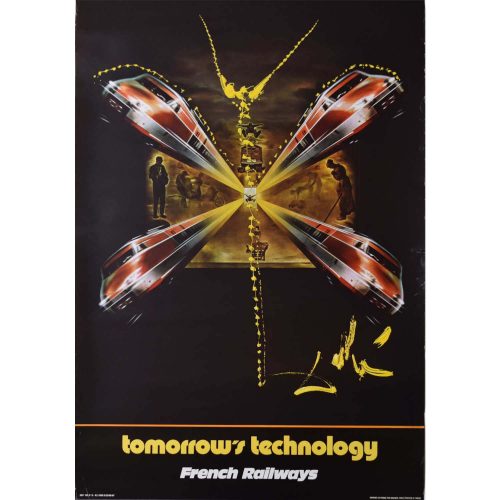
Salvador Dali Tomorrow's Technology
Original Poster for French Railways SNCF 60x37cm 1976 Signed in the plate Dali designed posters for SNCF for several years, a fruitful relationship. If you are interested email info@manningfineart.co.uk or call us on 07929 749056. Condition: Generally very good. -
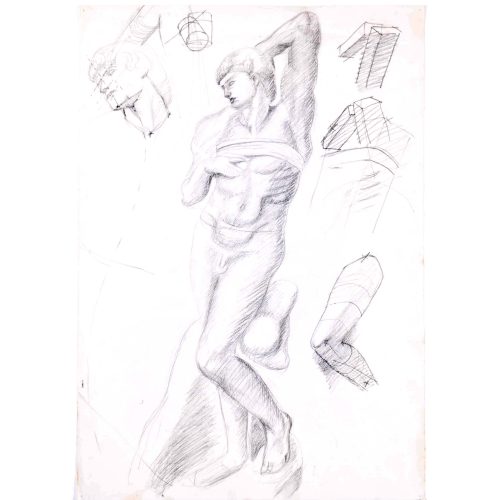
Hilary Hennes (née Hilary Miller) (1919-1993) Sketches of Figures c. 1940
56x39cm Pencil sketch A well-executed sketch. Miller was born in London, where her father was a curator at the South London Art Gallery. She attended Blackheath High School and, from 1936 to 1940, studied at the Blackheath School of Art and then for a further three years at the Royal College of Art. After graduating, Miller taught at the South East Sussex Technical College and in 1946 married the artist Hubert Hennes. The couple set up home in Oxford, where they both held teaching posts at the Oxford School of Art. Between 1948 and 1967 Miller frequently exhibited paintings at the Royal Academy in London and also illustrated a number of books on gardening and natural history, such as The Living World and Boff's Book of Gardening. If you are interested email info@manningfineart.co.uk or call us on 07929 749056. Condition: Generally very good condition, pin holes to corners toning to edge of sheet and occasional soft creases towards edges. -
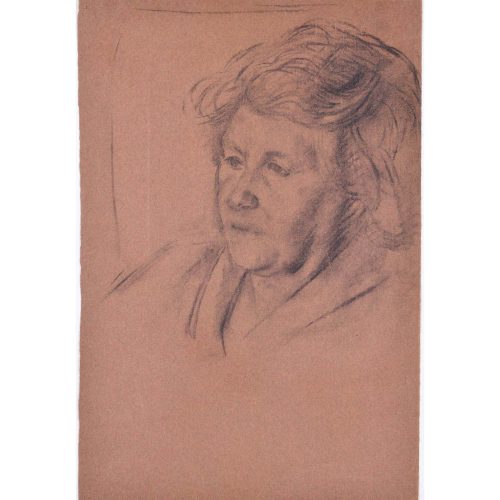
Hilary Hennes (née Hilary Miller) (1919-1993) Sketch of a Woman c. 1940
48x32cm Charcoal A well-executed sketch of a woman's face. Miller was born in London, where her father was a curator at the South London Art Gallery. She attended Blackheath High School and, from 1936 to 1940, studied at the Blackheath School of Art and then for a further three years at the Royal College of Art. After graduating, Miller taught at the South East Sussex Technical College and in 1946 married the artist Hubert Hennes. The couple set up home in Oxford, where they both held teaching posts at the Oxford School of Art. Between 1948 and 1967 Miller frequently exhibited paintings at the Royal Academy in London and also illustrated a number of books on gardening and natural history, such as The Living World and Boff's Book of Gardening. If you are interested email info@manningfineart.co.uk or call us on 07929 749056. Condition: Generally excellent condition, pin holes to corners. -

Claude Harrison Shell Guide to Westmoreland
Original poster for Shell Oil c. 1960s 76x51cm Shell commissioned a series of posters to go with their County Guide books, and they commissioned paintings by the leading artists of the day. Claude Harrison studied at Preston College of Art (1939-1941) and Liverpool College of Art (1941-2) after which he enlisted in the RAF for five years. On his return, he continued studies at Royal College of Art (1947-50). Harrison’s work consisted of murals, portraits, conversation pieces and mystical figure compositions - which are seen here in the Westmoreland poster. He was a member of the Royal Academy and his work has regularly been exhibited in the annual summer exhibition. If you are interested email info@manningfineart.co.uk or call us on 07929 749056. Condition: Fair. Short edge tears which are hidden by mount/mat; some age toning. Metal hanger removed to allow matting. See photograph for more information -
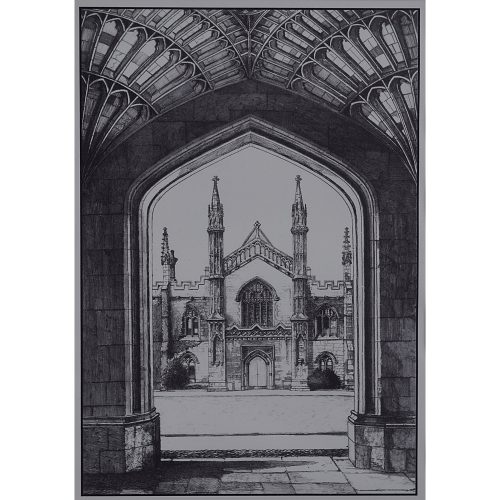
Tony Broderick (British, late 20th Century) Corpus Christi College Cambridge
Print 35x25cm A Lincoln-based artist, known for his portrayal of Lincoln and also of the Cambridge Colleges. If you are interested email info@manningfineart.co.uk or call us on 07929 749056. Condition: Excellent. -
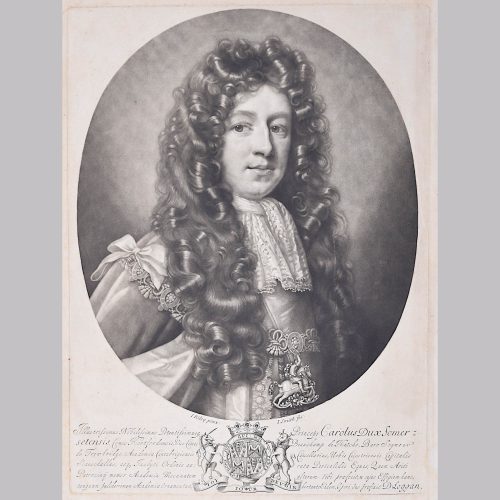
David Loggan (1634-1692) Charles Duke of Somerset
Mezzotint 1690 35x25cm Chancellor of Cambridge University, the Duke of Somerset's portrait was in Loggan's Cantabrigia Illustrata. Baptised in Danzig in 1634 Loggan's parents were English and Scottish. Studying engraving in Danzig with Willem Hondius (1598-1652 or 1658) he moved to London in the late 1650s producing the engraved title-page for the folio 1662 Book of Common Prayer. Marrying in 1663 he moved to Nuffield, Oxfordshire in 1665 to avoid the Plague and was in 1668/9 appointed Public Sculptor to the nearby University of Oxford having been commissioned to produce bird’s-eye views of all the Oxford Colleges. He lived in Holywell Street as he did this. Oxonia illustrata was published in 1675, with the help of Robert White (1645-1704). Following its completion he commenced work on his equivalent work for Cambridge, Cantabrigia Illustrata which was finally published in 1690 when he was made engraver to Cambridge University. Oxonia illustrata also includes an engraving of Winchester College (sharing its founder – William of Wykeham – with New College) whilst Cantabrigia illustrata includes one of Eton College (which shares its founder – Henry VIII – with King’s College). Bird’s-eye views required a particular talent as an architectural perspectivist of that era as it was not until 1783 that the first living thing (a sheep, named Montauciel ‘climb to the sky’) was sent aloft by the Mongolfier brothers in a balloon. Loggan thus had to rely on his imagination in conceiving the views. Loggan’s views constitute the first accurate depictions of the two Universities, in many ways unchanged today. Whilst the Oxford engravings were produced in reasonable numbers and ran to a second edition by Henry Overton (on thicker paper and with a plate number in the bottom right-hand corner), those of Cambridge were printed in smaller numbers and it is thought largely no second edition was produced, although this frontispiece proudly claims to have been published by Overton and a pencil note on the print suggests 1715 as a date. The Dutchman Pieter van der Aa published some miniature versions of the engravings for James Beverell’s guidebook to the UK Les Delices de la Grande Bretagne c. 1708. Edmund Hort New (1871-1931) produced a series of pen-and-ink drawings of views of Oxford that paid homage to Loggan showing the development of the city in the following two hundred years. They were turned into photoengravings by Emery Walker who published the series between . Probably no more than two hundred of each engraving were produced and the plates were destroyed in the blitz. The contemporary artist Andrew Ingamells (b.1956) has produced a highly-acclaimed series of etchings again bringing Loggan’s vision up to date. If you are interested email info@manningfineart.co.uk or call us on 07929 749056. Condition: Good. -
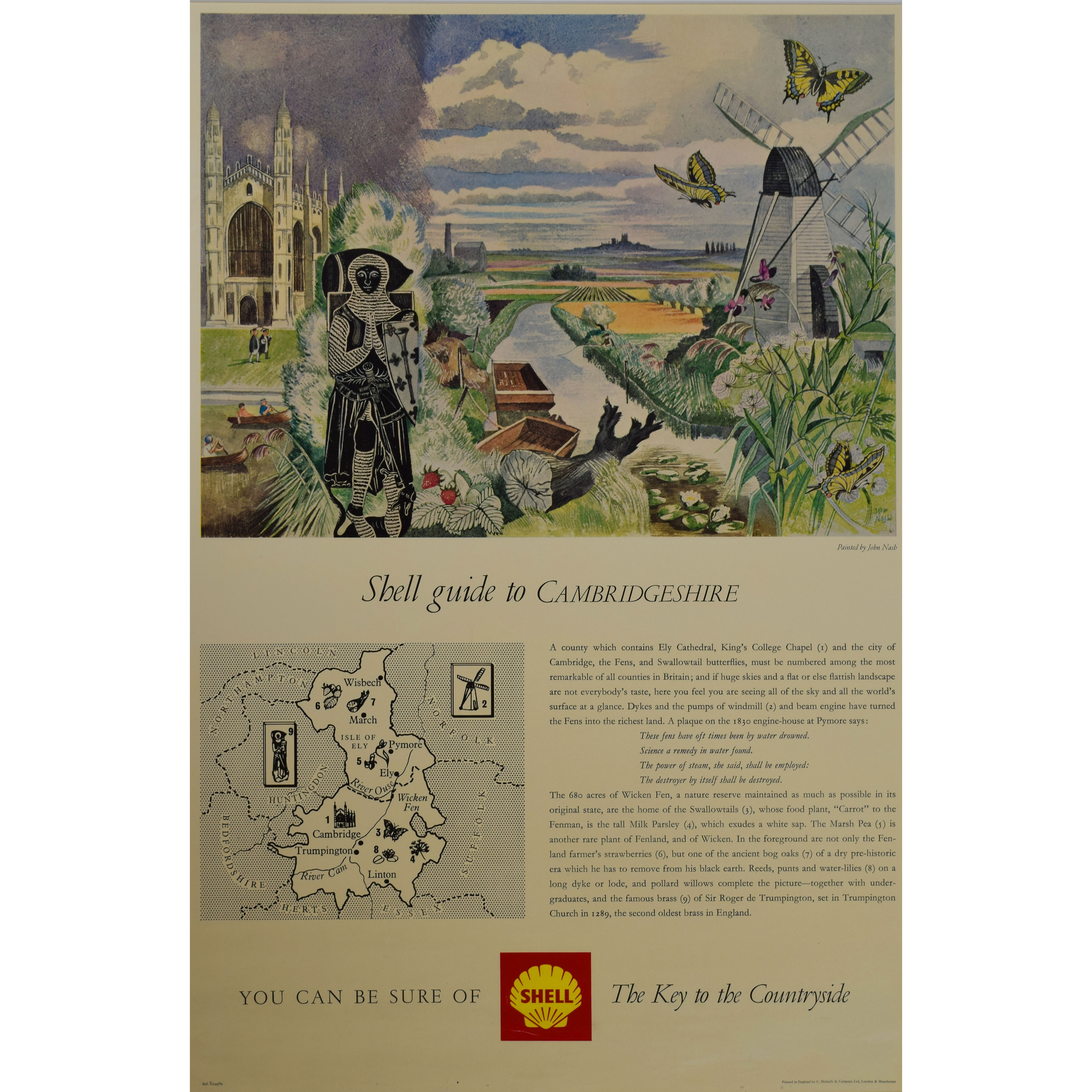
John Nash
Shell Guide to Cambridgeshire Original poster c. 1960s 76x51cm Shell commissioned a series of posters to go with their County Guide books, and they commissioned paintings by the leading artists of the day. Nash needs no introduction as an artist. A painter of landscapes and still-lives and illustrator - particularly of botanic works - who worked extensively with wood engravings, he was a natural choice for Shell. His most famous work is probably 'Over the Top' which hangs in the Imperial War Museum, relating to a counter-attack by 1st Battalion Artists' Rifles at Welsh Ridge on 30 December 1917. Of the eighty men who went over the top, sixty-eight were killed or wounded within the first few minutes. Nash escaped and painted the picture three months later. The Tate holds his 1918 painting 'The Cornfield' which was his first non-war painting (he only started painting in oils in 1914). Condition: mounted in conservation mount and wrapped in plastic sleeve (mount hides short edge tears). -
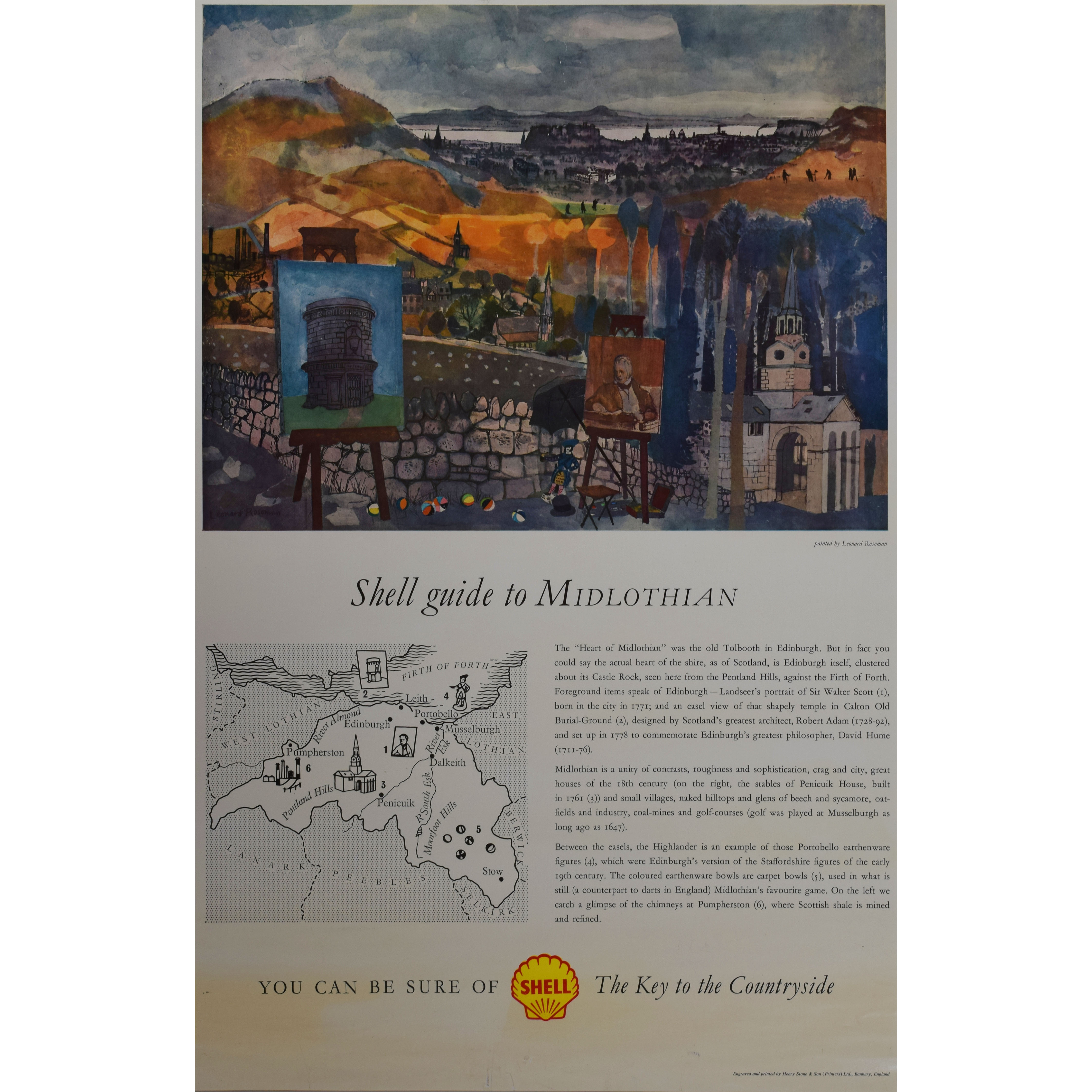
Leonard Rosoman
Shell Guide to Midlothian Original poster c. 1960s 76x51cm Shell commissioned a series of posters to go with their County Guide books, and they commissioned paintings by the leading artists of the day. Born in London, Rosoman studied at the Royal Academy Schools and then the Central School. His first major commission was to illustrate the popular children's book 'My Friend Mr Leakey' in 1937. Joining the Auxiliary Fire Service during World War II, he painted many scenes from the Blitz, some of which are in the Imperial War Museum collection. Seconded to the War Office in 1943 to illustrate books on fire-fighting the War Artists' Advisory Committee gave him a full-time post with the British Pacific Fleet, sailing with HMS Formidable the aircraft carrier. After the war he taught at Camberwell College of Art. He painted a mural for the Festival of Britain in 1951, murals for the British Pavilion at the 1958 Brussels International Exhibition, and for the restaurant at the Royal Academy's Burlington House - becoming RA in 1969. Condition: mounted in conservation mount and wrapped in plastic sleeve (mount hides short edge tears). -
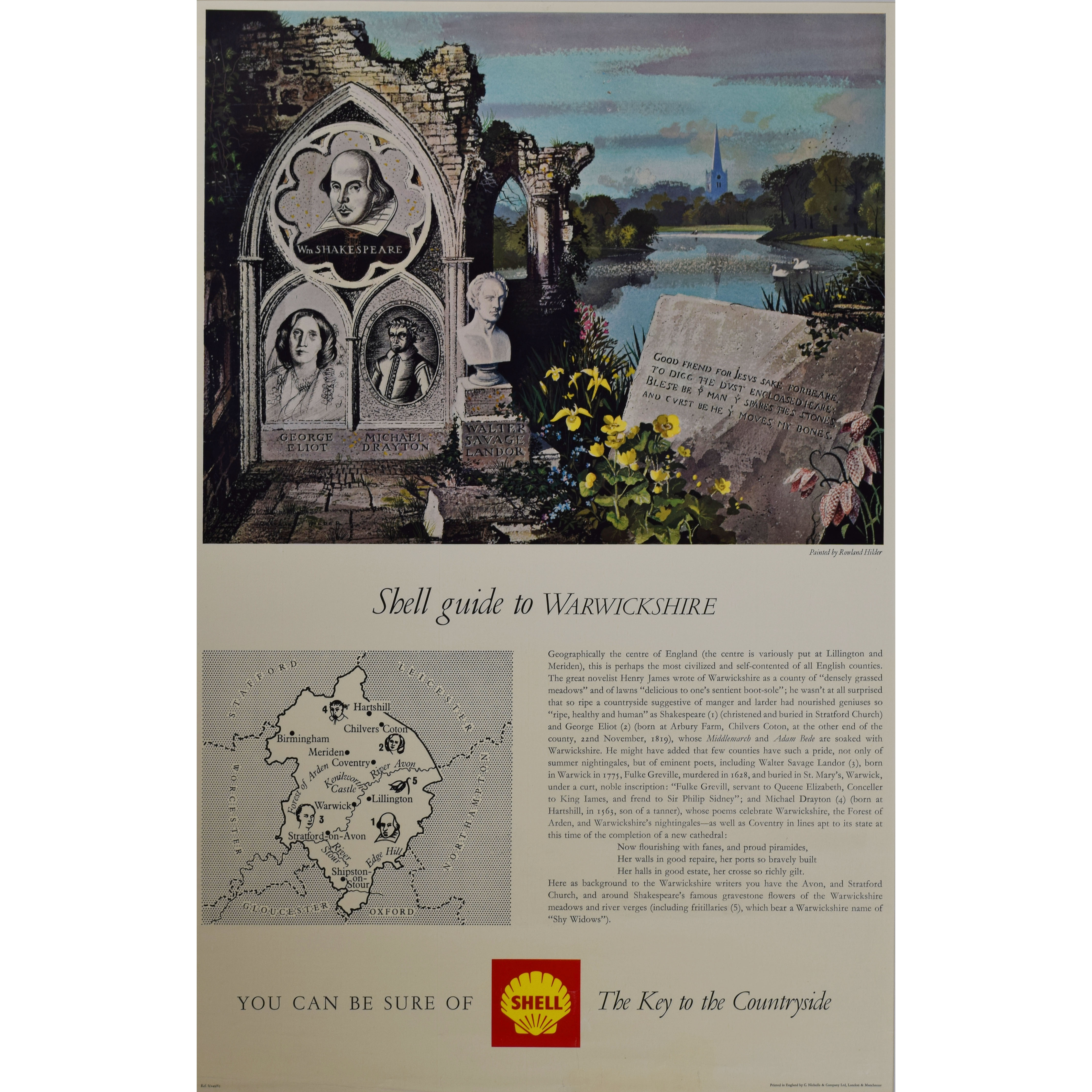
Rowland Hilder
Shell Guide to Warwickshire Original poster c. 1960s 76x51cm Shell commissioned a series of posters to go with their County Guide books, and they commissioned paintings by the leading artists of the day. Rowland Hilder was a well known landscape artist and book illustrator. Born in New York state, his English father moved the family to Kent, England in 1915. It was here his natural talent for drawing was noticed by his school. Later Hilder went to study at Goldsmith’s College in London. He was well known as an accomplished watercolorist, particularly in his sensitive handling of the sky and earth. Between 1964 and 1974 he was president of England’s Royal Institute of Painters in Watercolours. Condition: mounted in conservation mount and wrapped in plastic sleeve (mount hides short edge tears). -
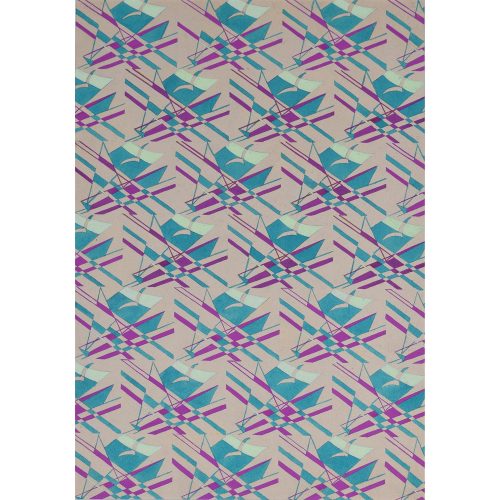
Margaret Macadam (1902-1991)
Seagull and Sailing Boat Wallpaper Design
Watercolour 27x20cm If you are interested email info@manningfineart.co.uk or call us on 07929 749056. -
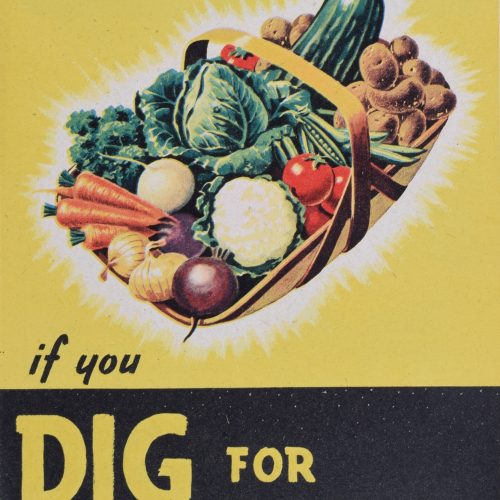
Dig for Victory Now
Norman Wilson, c1940
Dig for Victory Now Lithograph 18x12cm (7×4.7 inches), price includes frame. When rationing was at its height, what could be more appealing than a basket of fresh vegetables. What more incentive could be required to Dig For Victory Now? If you are interested email info@manningfineart.co.uk or call us on 07929 749056. -
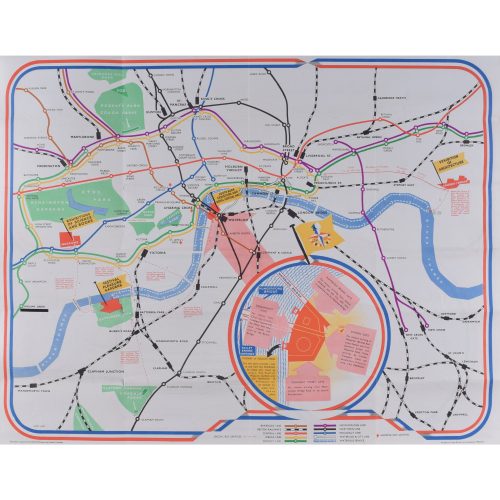
James Hart
Festival of Britain
Lithographic poster map 45 x 58 cm Folding map published for London Transport and British Railways for visitors to the 1951 Festival of Britain, featuring the Abram Games logo, details of water bus services, a detailed plan of the Lambeth exhibition area by Waterloo Bridge. If you are interested email info@manningfineart.co.uk or call us on 07929 749056. -
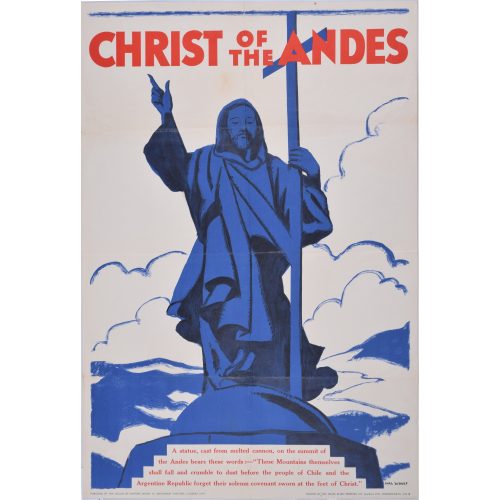 Hal Woolf Christ of the Andes Lithographic poster 76x50cm Printed by the David Allen Printing Co (London) Ltd., Wandsworth, SW18 Published by the League of Nations Union, 15 Crosvenor Crescent, London SW1 A statue, cast from melted cannon, on the summit of the Andes bears these words: "These Mountains themselves shall fall and crumble to dust before the people of Chile and the Argentine Republic forget their solemn covenant sworn at the feet of Christ." The League of Nations Union was formed in 2018 to promote international justice based upon the ideals of the League of Nations. Membership peaked in 1931 at over 400,000. In 1948 it was superseded by the United Nations Association. The statue of 'Christ the Redeemer of the Andes' is a monument unveiled in 1904 to celebrate the peaceful resolution of the border dispute between Argentina and Chile. If you are interested email info@manningfineart.co.uk or call us on 07929 749056.
Hal Woolf Christ of the Andes Lithographic poster 76x50cm Printed by the David Allen Printing Co (London) Ltd., Wandsworth, SW18 Published by the League of Nations Union, 15 Crosvenor Crescent, London SW1 A statue, cast from melted cannon, on the summit of the Andes bears these words: "These Mountains themselves shall fall and crumble to dust before the people of Chile and the Argentine Republic forget their solemn covenant sworn at the feet of Christ." The League of Nations Union was formed in 2018 to promote international justice based upon the ideals of the League of Nations. Membership peaked in 1931 at over 400,000. In 1948 it was superseded by the United Nations Association. The statue of 'Christ the Redeemer of the Andes' is a monument unveiled in 1904 to celebrate the peaceful resolution of the border dispute between Argentina and Chile. If you are interested email info@manningfineart.co.uk or call us on 07929 749056. -
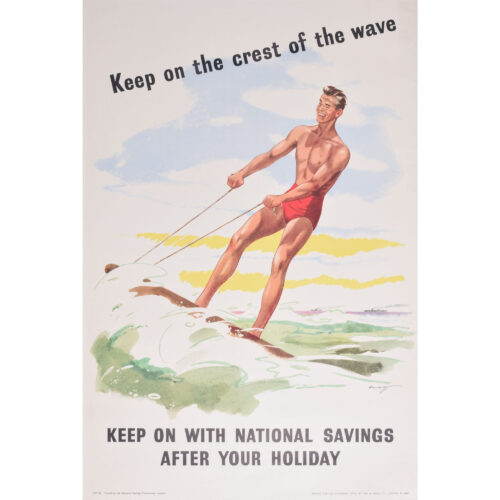
Keep on the Crest of the Wave
Original vintage poster 76 x 51 cm Issued by the National Savings Committee, London. Printed for HM Stationery Office by Fosh & Cross Ltd. An original vintage WW2 poster encouraging Britons to save via the National Savings scheme - like the cheery and composed surfer, we must keep saving to stay on the crest of the wave. Condition: generally very good; slight wear to right-hand margin. Not backed. If you are interested, please email info@manningfineart.co.uk or call us on 07929 749056. Click here for other original vintage National Savings posters. -
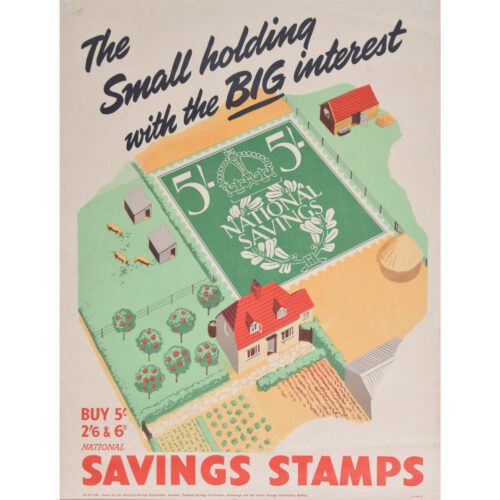
Savings Stamps - the Small Holding with the Big Interest
Original vintage poster 51 x 38 cm Issued by the National Savings Committee, London, the Scottish Savings Committee, Edinburgh, and the Ulster Savings Committee, Belfast. An original vintage WW2 poster encouraging Britons to save via the National Savings scheme. Condition: generally very good; few tiny edge tears, repaired; two pin holes to top corners; old fold as issued; and a couple of light creases. Not backed. If you are interested, please email info@manningfineart.co.uk or call us on 07929 749056. Click here for other original vintage National Savings posters. -
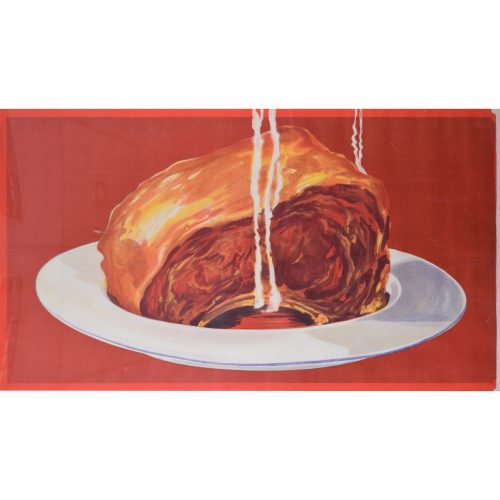
Rib of Beef
Original vintage poster 56 x 97 cm An original poster produced by Bisto to to advertise their gravy granules. With no lettering, the deep red poster is a bold and compelling advert which relies on the public's understanding that Bisto is the only choice. Condition: backed to linen, very good; a few repaired tears to right side. If you are interested, please email info@manningfineart.co.uk or call us on 07929 749056. Click here for other original vintage posters. -
Out of stock
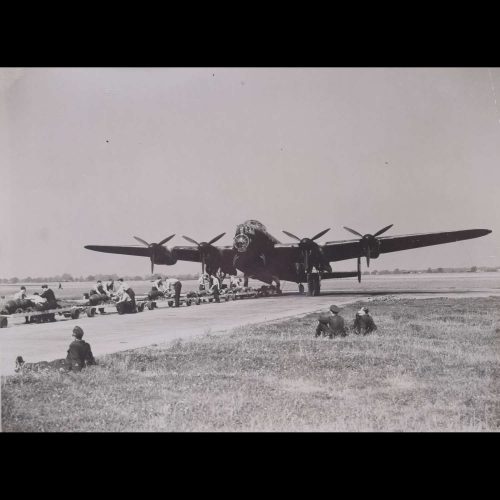
Lancaster Bomber being armed
Original Silver Gelatin photograph, c. 1942 16 x 21 cm Stamped to reverse 'Copyright this photograph must not be reproduced without the permission of Aeroplane' and 'This photograph has been passed by censor'. The photograph of the Swinderby based 50 Sqn - was taken in 1942. Either at the June reopening of the aerodrome with its new concrete runways (replacing grass) or in August when the photographers descended on the aerodrome again to take photographs for aircraft recognition purposes. Everitt survived the war - having flown 56 operations for which he was decorated three times, subsequently he was a bombing instructor, commanded a V-bomber squadron, and played golf into his nineties. He died in 2012 and the Telegraph published an excellent obituary. Provenance: from the collection of Philip J R Moyes, author of many books on the RAF, most notably The Pictorial History which ran to several volumes. -
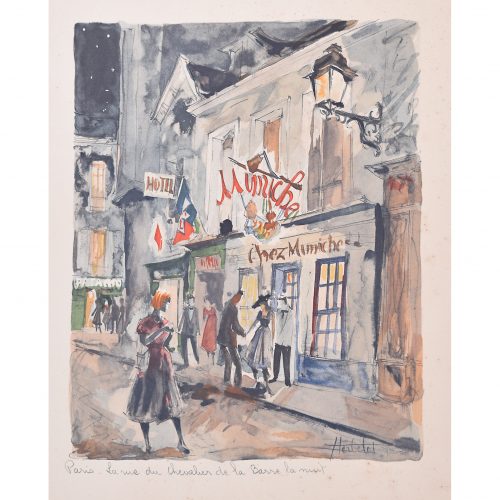 Franz Herbelot (French, active 1940s-1950s) Paris: La Rue de Chevalier de la Barre la nuit Lithograph 28 x 22 cm A fantastic lithograph by Herbelot which brilliantly captures the spirit of mid-century Paris. Little is known of Herbelot's life, but he is most notable for his views of Paris. The Rue de Chevalier de la Barre is a street in Montmartre named after the Knight de la Barre, François-Jean Lefebvre de la Barre, who died in 1766. Here, we see the street as it was in the 20th century, brimming with ladies and gentlemen dressed à la mode, bathed in the warm light of thriving bistros and hotels.
Franz Herbelot (French, active 1940s-1950s) Paris: La Rue de Chevalier de la Barre la nuit Lithograph 28 x 22 cm A fantastic lithograph by Herbelot which brilliantly captures the spirit of mid-century Paris. Little is known of Herbelot's life, but he is most notable for his views of Paris. The Rue de Chevalier de la Barre is a street in Montmartre named after the Knight de la Barre, François-Jean Lefebvre de la Barre, who died in 1766. Here, we see the street as it was in the 20th century, brimming with ladies and gentlemen dressed à la mode, bathed in the warm light of thriving bistros and hotels. -
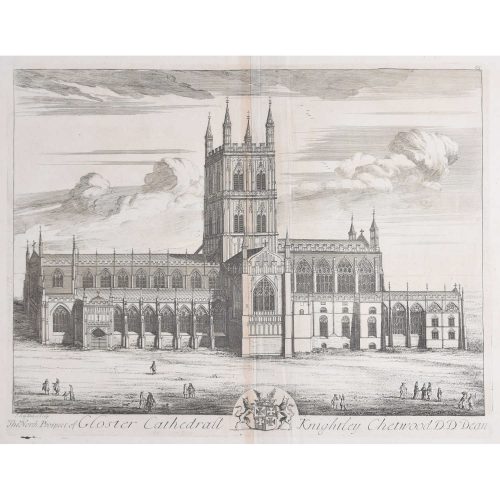
Johannes 'Jan' Kip (1652/3 - 1722)
The North Prospect of Gloster Cathedral (c.1716)
43 x 47 cm Copper engraving Johannes "Jan" Kip was a Dutch engraver, draughtsman and print dealer. After producing works for the court of William of Orange in Amsterdam, Kip followed William and Mary to London, settling in Farringdon and selling prints. Later, Kip collaborated with draughtsman and painter Leonard Knyff, and together they made a popular series of engraved views of English country houses. This print is from Sir Robert Atkyn's 'The Ancient and Present State of Gloucestershire'. In his usual manner - Kip was probably the foremost engraver of his time in England - he has placed figures before the Cathedral to give life - and scale - to the building. Condition: Generally very good with central vertical fold and adjacent parallel creases; one diagonal crease mid left to bottom centre. Will look very good when framed.

